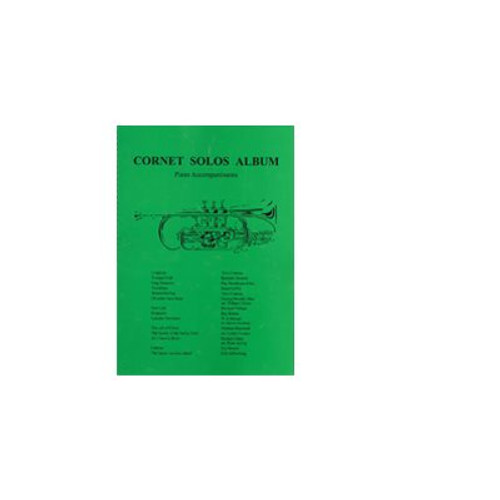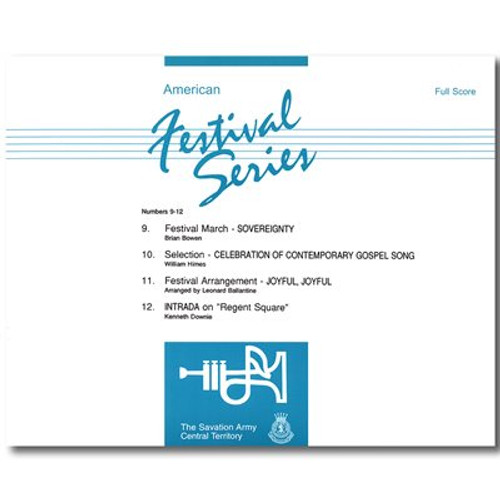Product Description
April 2020 Special Edition No. 64
Brian Bowen, Editor
Dr. Harold Burgmayer, Music Secretary, USA Central Territory
This special edition of the American Festival Series;Backorder=No features the cornet solo, Faith Pursuit by Martin Cordner, commissioned for Beth Malovance, principal cornet of the Chicago Staff Band. Based on the Sara Groves' song He's Always Been Faithful, the piece calls for the soloist to utilize digital delay effects. In the absence of full brass band accompaniment, an alternative piano accompaniment, prepared by Eric Dina is available.
64. Cornet Solo �� FAITH PURSUIT
Martin Cordner
Approximate duration 9:00'
Program Note
Commissioned for Beth Malovance, the cornet solo Faith Pursuit imaginatively explores the lure and temptations of the world countered by a pursuing God, who is offering redemption through simple faith. The thematic basis is Sara Groves' lovely song, He's Always Been Faithful. Enhancing the solo is the first Salvation Army use of digital delay effects.
Notes for the Soloist by Beth Malovance:
The use of the delay should be planned out carefully as though it is another voice or soloist. Particularly in the cadenza-like passages (mm. 7-15; mm. 79-86; and mm. 147-153), anticipate extra time for the phrase toe "breathe;" that is, allowing the full echo-effect to resound before moving onto the next phrase. In the melodic section (from bar 92), the pedal is used to add texture to the sound. Just before bar 112, be sure to turn the delay off for the final phrase, "He's always been faithful to me," in order to solidify the simplicity and wonder in that statement. After the fury of the recapitulation (from bar 156) and the big climax on the long "high D" (Bars 189-191), adopt a more majestic style from bar 200 and following. Demonstrate restraint in dynamics before a big finish to the piece.
The soloist may opt to add a volume pedal to the mix to avoid a "pop" caused by turning the delay switch off and on. Be sure to practice the timing carefully because the microphone is consistently picking up your sound, while simultaneously processing it through the delay. Remember that even if you do not have the volume switch depressed, your sound is being amplified into the speaker mix, Also if you turn it on too quickly, the last thing you played will get picked up and played until the effect is finished.
About digital delay: There are four main components needed for the use of a digital delay pedal setup:After the preamp, the soloist's sound will go through the delay pedal (commonly used by guitarists, but also available especially for brass instruments). A delay pedal is a time-based effect that adds an echo to one's sound. Delay pedals feature controls for the number of repeats for each note one plays, the time between each repeat, and the ability to mix the volume of the original sound and the delayed sound.
- Microphone
- Preamp (sound system or acoustic amplifier)
- Digital Delay pedal
- Power Source
Note to the Conductor:
Beginning to bar 19: An air of mystery pervades the opening bars moving from a solo bass drum roll to a seres of parallel muted trombone chords. The soloist begins at bar 7 with the digital delay effects on. The conductor needs to stay focused on the soloist's actual initial tones in order to give cues for each section entrance. Note the independent dynamic swells of the trombones and timpani glissandi in bars 10-11. A second bass drum roll at the conclusion of this first cadenza (bar 15) precedes the full band reiterating the opening parallel chords. Work for a wide dynamic range (swelling from mezzo piano to forte and back to mezzo piano) to achieve the full effect.
Bars 20-40: Carefully gauge the allegro giocoso tempo that commences at bar 20 with the soloist. Maintain a playful lightness to the accompaniment, punctuated by the fuller instrumental responses at the ends of phrases.
Bars 41-67: At bar 41, a sweeping two-bar legato phrase sets up a fanfare-like interlude in 3/4 time in the cornets and trombones, requiring brilliance of sound. The soprano cornet carries the lead over the four-part cornet chords. At bar 46, back in 4/4 time, very aggressive offbeat cluster chords (note the bass trombone is also features) introduce the second solo theme. This theme has a more determined, yet whimsical character. Most of the accompaniment to this section is simple three-note clusters in syncopation. Keep the tutti solo cornet and euphonium response from bars 52 to 55, as well as the syncopated punctuation in the lower part of the band, in very tight rhythm.
Bars 68-91: A foreshortened restatement of the opening solo theme transitions into a return of the opening cadenza idea at bar 79. Preceding that, bring out the timpani triplets in bar 77. This cadenza initially follows a similar scheme to the opening but slows unaccompanied by bar 87 into an introduction to He's Always Been Faithful.At bar 200, the soloist regains the melody in the upper register.
- Morning by morning I wake up to find
- the power and comfort of God's hand in mine.
- Season by season, I watch Him amazed,
- in awe of the mystery of His perfect ways.
- All I have need of, His hand will provide.
- He's always been faithful to me.
Bars 206 to end: Entering the closing section, maintain tempo while keeping the band's volume under control, assuring that the soloist's lines are not lost at any point. Exaggerating the rise and fall of the dynamics will aid this. At bar 212, the tempo slows significantly. The full band swells in volume from a subito mezzo piano over the final three bars.
- All I have need of, His hand will provide.
- He's always been faithful to me.
| Soloist Bb | 2nd Trombone Bb |
| Soprano Eb | 2nd Trombone B.C. |
| Solo Cornet Bb | Bass Trombone |
| 1st Cornet Bb | Euphonium Bb |
| 2nd Cornet Bb | Euphonium B.C |
| Flugel Horn Bb | Bass Eb |
| Solo Horn Eb | Bass Bb |
| 1st Horn Eb | Bass B.C. |
| 2nd Horn Eb | Percussion 1 (Mallets) |
| 1st Baritone Bb | Percussion 2 (Timpani) |
| 2nd Baritone Bb | Percussion 3 (B.D., Wind Chimes, Susp. Cym., Gong, Tamb., Tri.) |
| 1st Trombone Bb | 1st Trombone B.C |










